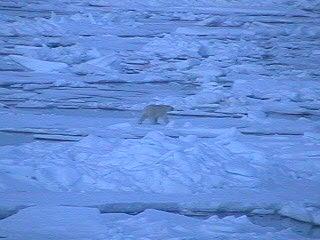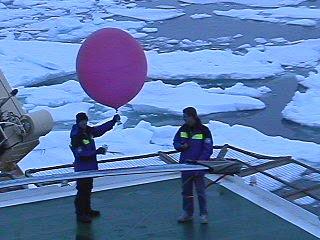
|
|
6 July, 2001
Ice Bear Friday, 6 July 2001
Hej! (Pronounced, "hay," meaning "Hello!")
Life on Board
In 1899, the great naturalist John Muir said polar bears move "as if the
country had belonged to them always." The big excitement of the day was
the approach of a large ice bear (polar bear) to within several hundred
yards of the ship at about 8:00 pm this evening. At that distance, it was
difficult to get a photograph and I hope that the bear doesn't just look
like a pale yellow dot in the white ice. Divers were in the water on an
ice floe near the ship along with their support personnel so they
immediately were recalled to the safety of the ship. I, too, would not
want to be in the water in a black wetsuit if a polar bear was nearby.
Everyone onboard was out on the decks with cameras and binoculars as the
bear approached then went around the ship. It was easy to lose track of it
in the jumbled blocks of ice but a few of our resident flock of seabirds
accommodated us by flying out and circling above it in hopes of getting a
free meal. It was curious but cautious.
The polar bear, Ursus maritimus, is considered a true marine mammal. Size
differences between males and females can be great, with adult males
ranging from 550 to 2000 pounds and females from 350 to 750 pounds. On
land, they travel at about 2.5 miles per hour but can charge for short
distances at 25 mph. When they break into a trot, they move like a camel,
with both legs on the same side of the body moving forward and back
together (Barry Lopez, Arctic Dreams).
Scientists at Work
The meteorological (weather) group is constantly taking air and weather
data as well as getting the most recent satellite data possible, which are
sometimes 24-hours delayed. They have 4 main ways of getting data:
sensors and equipment onboard the Oden, sensors and equipment on the
helicopter, a large Kevlar weather kite (tethered), and weather balloons
(disposable). They want to understand the vertical mixing in the
atmosphere above the Arctic, which differs greatly from the air above land,
so that they can relate this information to the gases produced by marine
algae and how these gases are distributed into the earth's climate cycle.
A large, red weather balloon was launched this afternoon from the
helicopter deck that contains a battery-operated scanner and several pieces
of equipment. The scanner reads and sends back data from the balloon's
instruments on pressure, temperature, and humidity. Using the known
atmospheric pressure gradient and the pressure and temperature on the
balloon, computers back on the ship calculate the balloon's height. They
can also calculate wind speed using LORAN-C satellite data, up until we
reach about 80o latitude when the satellites can't be seen over the
curvature of the earth. These balloons go up approximately 10 km (~6
miles) into the atmosphere, unless something goes wrong. They are made of
completely biodegradable materials, including the batteries, which is good
because they never come back.
Where Are We Now?
This Marginal Ice Zone station position is 78o20' N latitude and 27o30' E
longitude. The visibility was good today with no fog but there is thick
cloud coverage and a few pieces of blue sky. Tonight at midnight we head
back into the open water for our next station since the weather was too bad
during our last open water stop for the scientists to collect data.
E-MAIL! I finally can read my email but I can't reply to each personally
due to the extremely expensive satellite time although I will reply to some
using this section of my daily journal. First I want to thank everyone for
the well wishes and words of encouragement. Several of you asked me about
pictures on my Web site. I am trying to send some but it takes a
reeeeeeally long time to send even small pictures so we will see what
happens.
Lynette Bennett, Jane Nolan: Thanks for the messages and stories from
home. Kathie Stevens: Hello, Tennessee! I am glad to hear that another
teacher survived on an icebreaker. Dr. Landis: Nice to hear from you again
- I believe I was in your chemistry class at SDSU some 20 years ago, and
now, here I am on my way to the North Pole! Kevin Graham: No, I did not
"yak" in the rough water during the storm. Wayne & Marge Layton, Dick &
Shirley Wilkins: Hello to everyone in McCall, Idaho. I bet it is warmer
there than it is here! Enjoy some trees for me. Matt Steitz: My Iridium
satellite connection is tenuous at best and this makes Internet accessing
extremely annoying since I send these journals and pictures through a Web
site. I sometimes have to hit "Refresh" 6 times before it is able to open
a Web page. Meanwhile, the seconds and dollars are ticking.
Vi ses! (See you later!)
From Deck 4 on the Icebreaker Oden,
Dena Rosenberger


Contact the TEA in the field at
.
If you cannot connect through your browser, copy the
TEA's e-mail address in the "To:" line of
your favorite e-mail package.
|
